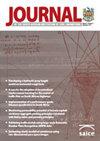南非水泥用天然沸石沸石的试验研究与分类
IF 0.6
4区 工程技术
Q4 ENGINEERING, CIVIL
Journal of the South African Institution of Civil Engineering
Pub Date : 2022-12-13
DOI:10.17159/2309-8775/2022/v64n4a1
引用次数: 1
摘要
本研究考察了南非天然沸石作为水泥扩展剂的潜在用途。据作者所知,所研究的天然沸石以前从未在水泥工业中用作沸石,而其在混凝土施工中的应用将是新的。在研究中,用普通硅酸盐水泥CEM I 52、5N与0、10、20、30%天然沸石混合配制砂浆。并将天然沸石的效能与30%粉煤灰混合料的效能进行了比较。进行了和易性、抗压强度、与石灰的火山灰活性、干燥收缩率、碱-硅反应和耐硫酸盐性等试验。利用x射线衍射、扫描电镜和能量色散光谱进行了分析研究。研究发现,天然沸石掺入水泥虽然降低了水泥的和易性,但其对水泥力学性能和耐久性的影响优于粉煤灰,因为前者有效地提高了水泥的长期强度,减轻了水泥的干燥收缩、碱-硅反应和硫酸盐侵蚀。在水泥中掺入20%的天然沸石具有有效的整体性能,符合ASTM C618 (2015) N级火山灰的标准。根据EN 197-1 (2000) / SANS 50197-1(2013),天然沸石与普通硅酸盐水泥的共混物符合CEM II/A-P 32.5N,R水泥类型的分类标准。本文章由计算机程序翻译,如有差异,请以英文原文为准。
Experimental study and classification of natural zeolite pozzolan for cement in South Africa
The present study investigated the performance of South African natural zeolite for potential use as a cement extender. To the best knowledge of the authors, the natural zeolite studied has not been employed before as pozzolan in the cement industry, and its proposed use would be new in concrete construction. In the investigation, mortar mixtures were prepared using ordinary Portland cement CEM I 52,5N blended with 0, 10, 20 and 30% natural zeolite. The effectiveness of natural zeolite was also compared with performance results of mixtures containing 30% fly ash. The tests conducted were workability, compressive strength, pozzolanic activity with lime, drying shrinkage, alkali-silica reaction, and sulphate resistance. Analytical studies were done using X-ray diffraction and scanning electron microscopy coupled with energy dispersive spectroscopy. It was found that, while incorporation of natural zeolite in cement reduces workability, its effects on mechanical properties and on durability characteristics were superior to those of fly ash, as the former effectively enhanced long-term strength and mitigated drying shrinkage, alkali-silica reaction and sulphate attack. Incorporation of 20% natural zeolite in cement gave an effective overall performance, meeting the ASTM C618 (2015) criteria for Class N pozzolan. Based on EN 197-1 (2000) / SANS 50197-1 (2013), the blend of natural zeolite and ordinary Portland cement met the criteria for its classification as CEM II/A-P 32.5N,R cement type.
求助全文
通过发布文献求助,成功后即可免费获取论文全文。
去求助
来源期刊
CiteScore
0.70
自引率
25.00%
发文量
19
审稿时长
>12 weeks
期刊介绍:
The Journal of the South African Institution of Civil Engineering publishes peer reviewed papers on all aspects of Civil Engineering relevant to Africa. It is an open access, ISI accredited journal, providing authoritative information not only on current developments, but also – through its back issues – giving access to data on established practices and the construction of existing infrastructure. It is published quarterly and is controlled by a Journal Editorial Panel.
The forerunner of the South African Institution of Civil Engineering was established in 1903 as a learned society aiming to develop technology and to share knowledge for the development of the day. The minutes of the proceedings of the then Cape Society of Civil Engineers mainly contained technical papers presented at the Society''s meetings. Since then, and throughout its long history, during which time it has undergone several name changes, the organisation has continued to publish technical papers in its monthly publication (magazine), until 1993 when it created a separate journal for the publication of technical papers.

 求助内容:
求助内容: 应助结果提醒方式:
应助结果提醒方式:


